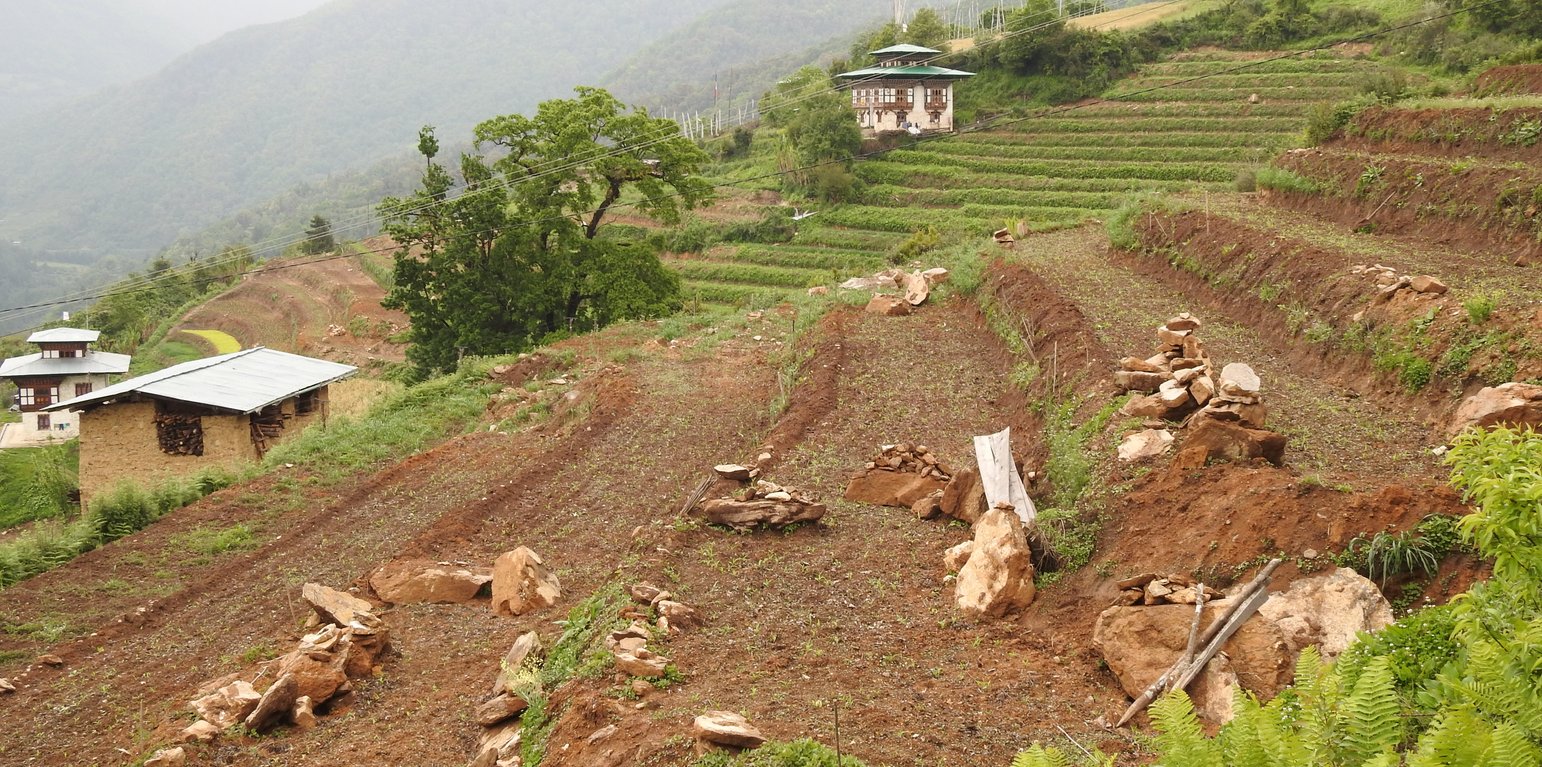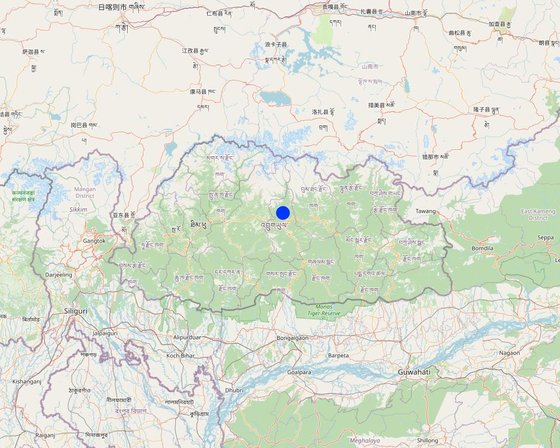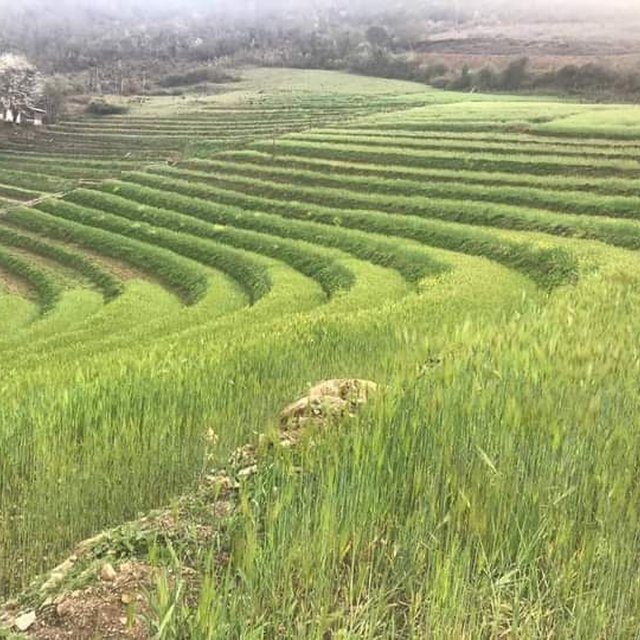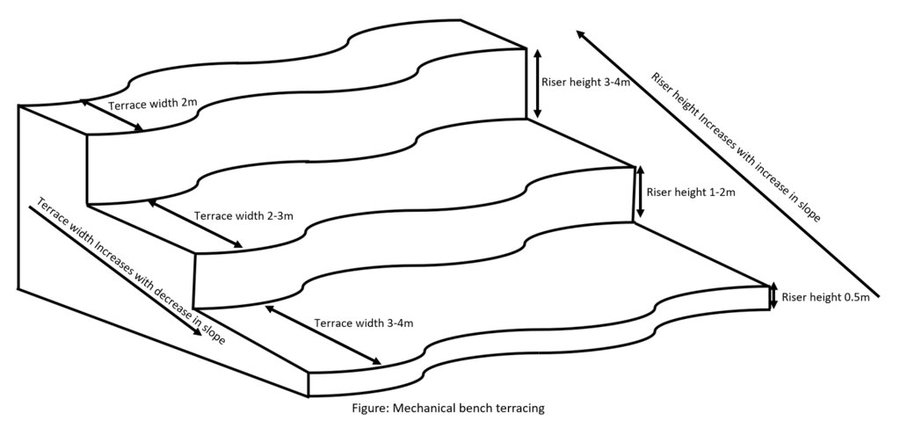



Bhutan is one of the most mountainous countries in the world and agricultural activities are carried out on slopes up to 35 degrees (70 percent). Erosion by water is one of the major causes of land degradation. In such areas, effective erosion control measures include reducing slope gradients to minimize runoff by creating a series of level platforms or “bench terraces” along the contour. Current bench terracing is made using small to medium-sized earthmoving machines called excavators, and thus the technology is called Mechanical Bench Terracing. This is one of the main SLM measures promoted widely and most preferred by landowners who claim that it reduces soil erosion, improves soil fertility, conserves soil moisture, and eases field operations. Bench terraces create impact by 1) helping minimize the risk of soil erosion caused by surface runoff, 2) effectively regulating water flow, and 3) preventing soil saturation by allowing better drainage. Additionally, bench terracing transforms previously unusable or less productive land into cultivable areas, maximizing the utilization of limited land resources. A typical bench terrace on a 20-25 degree slope has a terrace bed of 2-5 m meters and a riser of 0.75 to 1 metre high. The risers are made of earth and the terrace is made flat most of the time to prevent runoff of rainwater.
Establishing and maintaining bench terracing involves a feasibility study of the sites, participatory planning, hands-on training of the landowners, and surveying of contour lines using A-frames. There is also procurement of construction materials, arranging labour and machines and training machine operators. Once constructed, proper water management, soil fertility, and nutrient management practices are crucial for ensuring the long-term sustainability and productivity of the terraced land. Furthermore, knowledge and training on crop cultivation techniques, field management, and maintenance are vital to optimize the benefits.
In summary, bench terracing offers numerous benefits. These include:
1) Overall reduction in land degradation
2) Soil conservation by prevention of erosion by runoff
3) Conservation of soil fertility
3) Increase arable land available for cultivation
4) Ease of mechanized field operations with level terrace beds
5) Water conservation and drainage6) Improved crop production
Land users like the fact that bench terracing provides land that is easier to work. The land is better utilized for cultivation, resulting in improved productivity. Land users generally appreciate its numerous benefits in terms of land productivity, soil conservation, and water management. What they dislike are the expense and labour input if expenditure has to be borne by the land owners and neither machine operators nor small to medium-sized machines are readily available in the market for hire.

Localização: Bemji Village, Nubi Gewog (block), Trongsa Dzongkhag (district), Trongsa Dzongkhag (district), Butão
Nº de sites de tecnologia analisados: Local único
Difusão da tecnologia: Uniformemente difundida numa área (1.0097 km²)
Em uma área permanentemente protegida?: Não
Data da implementação: 2019
Tipo de introdução






| Especifique a entrada | Unidade | Quantidade | Custos por unidade (Ngultrum) | Custos totais por entrada (Ngultrum) | % dos custos arcados pelos usuários da terra |
| Mão-de-obra | |||||
| Labour | person-days | 98,0 | 500,0 | 49000,0 | 100,0 |
| Equipamento | |||||
| Excavator | nos | 1,0 | 40916,0 | 40916,0 | |
| Custos totais para a implantação da tecnologia | 89'916.0 | ||||
| Custos totais para o estabelecimento da Tecnologia em USD | 1'115.31 | ||||
Quantidade anterior à GST: Before 1,814 kgs/acre
Quantidade posterior à GST: After bench terracing 1,971 kgs/acre
According to the land user, there has been increased crop production.
According to the land user, the quality has relatively improved but is unable to describe the changes, however, he observed changes in the size of the grain and enhanced grain filling ability.
Quantidade anterior à GST: In the past, the land owner has been growing only wheat or barley
Quantidade posterior à GST: Now the owner is growing paddy followed by wheat or barley in a year
The land user shared that the number of crops grown in the area has increased, and people also started commercial farming.
Quantidade anterior à GST: 23 acres of land
Quantidade posterior à GST: 2.4 acres of land are currently being cultivated after bench terracing
This is probably due to the lack of labour and some of the farm lands located very far from the home/settlement.
The land users shared that after bench terracing, the management of land has greatly improved. This is evident from the quality of crops that they grow on the terrace. Working on the land is also easy unlike working on slopes.
Quantidade anterior à GST: Before bench terracing the owner used oxen for ploughing
Quantidade posterior à GST: Now they use power tillers and cost have reduced for agriculture farming
Other objective of promoting bench terracing is also to enable farm mechanization.
Before bench terracing the land owners use the field for growing only wheat or barley. After bench terracing they grow two crops in a year, paddy followed by wheat or barley
Since the land is on a sloping area there is surface and rill erosion in the past, but after the bench terracing, the incidences of surface and rill erosions are minimal
As the terraces field are used for paddy cultivation there is no excess water. Even if there is excess the land owner can easily drainage to water ways
Erosion was easily observable in the past due to the agricultural land being on mountain slopes. However, now, due to the series of levelled land, water erosion and landslides are no longer observed.
Before terracing rainwater is lost due to surface runoff however with terracing surface runoff is prevented as a result the amount of irrigation water required has reduced. Thus increasing water availability.